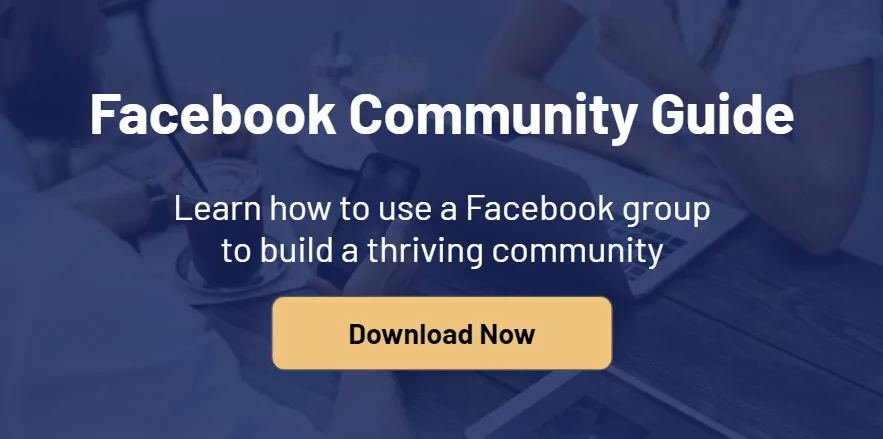Easy to use and accessible, a Facebook group is a great way to bring people together around a subject or cause. But, how do you go about creating a dynamic, vibrant, growing Facebook group?
Well it’s a lot easier than it sounds, and in the process you can create a true community that offers real value for its members.
So let’s dive into the nuts and bolts of Facebook groups, including how to create them, the best tips and tools for managing them and the content that will engage your members to help your Facebook group grow.
Why would you create a Facebook group?
A Facebook group is a great way of creating a community around a common cause, whether that’s business interests, hobbies, education, or simply networking.
The major benefit of a group is, it creates a place where there is focussed attention and interaction around a common topic.
In the process, a Facebook group can help build your profile, your organization’s profile, or the image of your brand.
It also provides your audience with a unique way to get to know you, as they feel like they are part of your inner circle.
In the interim, a group provides a place of instant engagement. You can quickly disseminate information such as posts and videos, but you can also seek instant feedback via polls, questions, discussion topics, and themes.
Groups also have a unique ability within Facebook to move up the search rankings as people receive notifications about them, interact within the group, and regularly check in. This engagement is key to Facebook’s current algorithm.
If you’re a business, Facebook groups are a great way to present offers such as sales, discounts or special VIP offers specifically targeted to an engaged audience.
As the profile of the group grows, you can also bring in expertise to cater specifically to that topic or answer questions your members may have. In other words, the profile of the group gives it credibility and allows it to become a go-to resource that genuinely assists its members.
Finally, if you’re running a group in your niche or area, you as the group founder get to understand your niche and your market better.
Related: 7 Steps To Building An Online Community (With Examples)
Steps to set up your group
- Define your topic
Facebook is a great place to come together and network around a common topic, but what will that topic be?
It could be a topic or subject around your industry, it could be a common problem that needs to be solved, or a mastermind group, which is supporting a course or people in a specific sector/industry.
It could also be for a community cause or something to do with your workplace, such as a space for your staff to interact.
It could be a VIP group for local businesses.
Once you’ve defined the topic, you need to write down the pros and cons and the value your group will offer.
This then assists with naming the group in line with what people will be searching for.
- Naming your group
Your name is important. The right name will help your Facebook group grow organically.
Consider what people will search for. Are you going to have your business or brand name in there, or perhaps your personal name in order to build your profile as an expert in your field?
When it comes to naming, the most important thing is to keep it simple, keep it short, consider keywords, and view it from the perspective of what people would search in order to find it.
- Define your purpose / goals / target audience
As you work through the process of defining a topic and creating a name, it’s important to consider what your group will stand for and also what it will do.
Who exactly is your target audience, and what information will be of benefit to them within that group?
Understanding your target audience is a lot like identifying your ideal customer in business, it involves nutting out who that person will be, what they do, where they come from, and how old they are likely to be.
Knowing your target audience allows you to curate content for them, and grow that group quickly by offering information and discussions that are of specific interest to them.
In the process, you should also understand your group’s purpose. Is it there to support or educate, is it perhaps a forum for discussion? Often it will be a few of these things. But understanding your group’s purpose assists when it comes to creating content and guidelines.
In other words, what does it stand for, what value will it bring, and what will it be known for?
A great way to crystalize this thinking is to set goals for what you want your group to achieve. These goals take a couple of forms. There are goals that are a bit like a vision statement that set the overall tone for your group.
Then there are the personal goals that the group may serve to you, such as:
- To build your brand
- To establish your authority in a space
- To market special offers
- To assist your members
- Great guidelines make great groups
When it comes to managing a community of people, guidelines are a must. Your Facebook group’s guidelines come from the philosophy of what the group is about, and what benefit it will have to the community.
These guidelines are ultimately what makes a group, so it’s about asking, what do you want people to be able to do within the group?
Guidelines to consider include:
- Whether or not unsolicited personal messaging is allowed
- Behavior that will not be tolerated (such as abuse, swearing etc). In a debate people might get emotional, so it’s important to establish what the group will or will not accept.
- How often people are allowed to post offers or promotions (once a group turns into a spam-fest, members often switch off).
- Any no-go topics that are not to be discussed within your group (politics or religion, for example)
These guidelines reflect what your group stands for, setting the tone for your community.
Make sure to set your guidelines down before creating the group, and don’t change them too regularly – in doing so you risk alienating your members.
- Create a Facebook page for your group (if don’t already have one)
If you’re looking to promote your group, or it’s related to your business, it’s a great idea to create a Facebook page that links to it.
Remember, however, a Facebook page and a Facebook group are quite different things.
Where a page is a public profile that allows companies and brands to introduce their services and activities, a group is a community-based feature that gathers people with the same interests to discuss topics and share their opinions.
Your Facebook page can then be used to promote your group, by encouraging people who view that page to join the discussion.
- Create your group
Creating a Facebook Group is fairly simple courtesy of Facebook’s easy-to-use platform.
To create a group:
- go to facebook.com/groups/create/
- In the left toolbar, add the group’s name, select the desired privacy level, and invite any initial people who will either assist with administration or be part of your group
- Push the Create button. You now have a group, but there are a few more details to fill in
- On the main page, add an image for your group
- Fill in the About section that illustrates what your group does or offers
- Click the badge which says manage group. On the left-hand toolbar, you can start entering qualifying questions you might like to ask, group rules, or parameters for members such as age restrictions.
- Qualifying questions
Facebook has a great feature that allows you to qualify people before they can enter your group.
These qualifying questions allow you to ensure your members value the community and are aware of what it stands for.
The questions also act as a non-negotiable entry point, as they have to be completed before a new member is allowed in.
Questions might relate to what the member would like to get out of the community or perhaps what their business is (to see whether the group is relevant to them).
Alternatively, you could ask what their interest is, or what their preferred topic is.
You might also ask them to agree to read and follow the group guidelines, which acts as a way of having them accept the terms and conditions, and adhere to the behavior expectation inside the group.
Meanwhile, another great question to ask is whether they would like to receive your newsletter.
Together these questions ensure your group is vetted and each member is qualified to be a part of your community.
- Public or private?
There are different types of groups and one of the most common questions is what’s the difference and which is right for me?
- Public – A public group can be seen by everyone, and the members of the group are also seen publicly. This might be the type of group you establish for sales and promotions.
- Private – Private groups allow people to find the group then apply to join via qualifying questions or administrator permission.
In many ways the private group offers the best of both worlds – the group can be discovered online, but the members who are part of that group are vetted. Only members can see the content posted in that group. They can also see the other members who have joined.
Private groups can also be hidden, so they cannot be found by searching. A hidden private group might be something you use to support a specific cause or event.
- Posting within your group
As you create your group, you might also wish to consider the rules around posting. Will it be open posting, or admin-approved posting?
Open posting allows members to post whatever they wish (hopefully in accordance with those guidelines mentioned earlier).
The benefit of open posting is that it allows engagement to be instant and there are no delays to people asking a question or posting on a topic.
It does, however, mean the administrator/s might need to pop in more regularly to ensure everyone is behaving as they should and operating within the guidelines.
Admin-approved posting means that any proposed post has to first be approved by an administrator of the group.
The benefit is, all posts are moderated. However, on the negative side, it slows down communication in the group and can create additional work for the administrator.
Ultimately, selecting open or admin-approved posting comes down to your preference for how you wish your group to operate.
Launching your group
Now you’ve created your group, you will be looking to recruit some members and perhaps create a little buzz around your new offering.
This is where your Facebook page and other existing channels come into play.
- Send to your existing audience
The best way to initially alert people to the launch of your group is to tap into existing channels, which might include:
- Posting on your Facebook age and inviting people to join
- Sending out an email blast to contacts in your CRM
- Creating a link on your website and announcing it there via a blog post
- Initial content for your group
You don’t want new members to simply hit a blank page when they arrive at your group, so it pays to think about creating some initial content in advance of announcing your group to your audience.
Initial content might include a pinned post of the group guidelines, but will also extend to a welcome message, a brief outline of what the group will do, and then perhaps a question to foster engagement.
Remember engagement is key to Facebook groups. They’re all about your members interacting with each other and receiving value. So, think about some initial questions you might want to ask shortly after your launch, in order to engage your members.
Ideas to seed initial engagement include:
- What are you hoping to gain from this group?
- What’s your biggest challenge (related to the group topic) right now?
- What’s the most important question you want answered?
- Or even simple things like how has your day been, or what’s been your biggest win this week?
Pro tip – To get people talking initially, instead of sending an email about a blog post and asking for your readers to leave a comment on the post itself, ask them to discuss it in the group. Give them specific talking points, or if it’s a big issue, set a time for a group discussion.
Promoting the group
Once you have a group and have alerted members of your existing audience, it’s time to focus on growth by highlighting what it is your group does and the value it offers.
There are various ways to go about promoting your group, so let’s look at a few…
Targeted Facebook ads
You can harness your Facebook page to create targeted ads that are likely to attract like-minded individuals to your group to become members.
This is a great way of using Facebook’s power to extend your reach beyond the people you already know and the places you are already seen.
Cross-promote with other groups
Often large networking groups will allow you to share the details of a group that may be relevant to their members within their page.
If invited to, or if appropriate, cross-promote your group within other groups.
Influencers in the group
Influencers bring credibility to a group. They also potentially bring a large audience. If appropriate, consider inviting in an influencer whose ethos aligns with your group’s values.
Ask group members to share
As your group grows, it’s an indication that existing members are enjoying the content you provide and find value in your offering.
You can tap into this trend by asking members to share the group or invite their friends.
Don’t forget to tell people
When you’re out networking in person, don’t forget to tell people you run a Facebook group, if it might be relevant to them. You can also include the details on your business card, or ensure it’s easily linked to from your website.
Building engagement in your group
It is engagement that gives your group value and the momentum it requires to grow. Your role as the group creator is to foster this engagement through great content and discussion starters that keep people coming back for more.
So how do you build that engagement?
To create engagement, you need to engage
As an administrator or group creator looking to foster engagement, you need to actively engage frequently yourself, whether that’s checking in, starting a discussion, responding to a question or comment, or pointing your members in the direction of the knowledge they seek.
Here are just some of the tools and ideas you can use:
Theme days
Theme days encourage people to come back and engage in conversation on a regular basis. They are a proven way to encourage participation while also structuring the content and direction of your group.
Consider theme days like “Hot Offer Wednesday” where people post their offers, or “Find The Answer Friday” where people pose and answer questions within a group.
Ask for feedback
End relevant posts with a question that actively seeks feedback such as “what are your thoughts?”, “have you had a similar experience?”, or “ what three things would you do in this situation?” etc.
Clever questions
How was your day? How did you find XYZ? How do you feel about XYZ? What was your ‘yay’ moment for the week?
You can download a comprehensive guide of conversation starters and clever questions here.
Polls
Polls are super simple to create and offer a quick way to foster engagement. Simply poll your group on something relevant to them, whether it’s a recent news announcement relating to them, or a more generic question like asking them to select their favourite tool for doing XYZ.
You can even poll the group on an expert they’d like to hear from, or a topic they would like to see discussed in greater depth.
The bonus benefit of a poll is that it can often point you in the direction of further content the group might be interested in.
Facebook Lives
Facebook Lives by you the administrator, or perhaps an invited guest, offer a visually compelling type of content that can be tailored to hot topics, new initiatives, product launches and a whole lot more.
For example, the government may announce something that’s relevant to the members of your group or their business. So, you jump into the group and do a live that explains what exactly that announcement means to them.
You can also do Lives on set topics that you’ve planned in advance and then invite the group to tune in at the right time.
Invited guests
If you’re really looking to add value to your group, invited guests are a great way to do it. You set a theme, invite in an expert and allow the group to ask them questions.
This invited guest may also kick off their time in your group with a Facebook Live that people can then ask about or comment upon.
Invite questions from your members
When you encourage your members to ask questions, it’s native content that fosters discussion. It also taps into the value of the group as a place to share knowledge, insight, resources and expertise.
How-to videos
How-to videos are another great way of assisting your members, and you can foster engagement by asking them about the top things they wish to learn about.
You can also create how-to videos on new products, services or processes that might be relevant to the group’s niche.
Memes
Whether they’re inspirational or ironic, memes are hugely popular items of content that often elicit engagement in terms of likes and discussions.
They’re also super easy to source or create using great tools like Canva.
GIFs
Like memes, GIFs are a really simple way of drumming up engagement quickly, particularly when they have a touch of humour to them. If you’re looking for GIFs, resources like Giphy can assist.
Basically, the ideas for creating engaging content are really only limited by your imagination, but if you are looking for further ideas on content for your Facebook Group, you can download a PDF here.
Tying it together and next steps
Facebook groups can be a hugely effective way of creating a community around a common cause while raising your profile and showcasing your expertise.
Groups can also be used for education, networking, promotions, and so much more.
They do, however, take work. Even after you create your group, you will need to promote it and administer it, ensuring that group is known for the things you want it to be known for, and doesn’t stray off course.
There may also be times when you need to slow the growth of your group, and that’s OK too. It’s important to be effectively managing the group you have rather than just adding new members ad hoc.
The reality here is some of the most successful groups will occasionally note they are not taking new members at certain times.
Not only does this create a sense of exclusivity, it also allows the group’s administrators to ensure the current group is functioning as it should and remains a place that stays true to its guidelines and purpose, while offering real value to its members.
And that’s the important aspect of any group, it should offer a value and a sense of community to its members.
Ultimately, your group may prove so successful, it becomes an asset that can be monetized. But in the interim, here are some final tips and steps to take once your group has been established
Final Tips
- Set your guidelines early and stick to them – Guidelines are the glue that holds your group together, setting the bar for how it will work and feel.
- Be active, supportive and encouraging – Commit to giving your members a piece of your time each and every day.
- Encourage your members to share their wins – It can be lonely out there at times so sharing wins of any size is important. Foster that as often as you can.
- Encourage your group members to report posts they feel are outside the group guidelines – This will save you loads of time rummaging through every post, and helps members to feel that they are truly part of the community.
- Not everyone will love your group and that is OK – Groups are about community and finding the right people who will fit.
- Do things for your group – engage with them and get to know them by creating challenges, webinars etc just for them.
- Share the group around – Like all things, people have to know about you to find you, so remember to share your group with people!
You can learn more about creating Facebook Groups and even monetizing them at Linda Reed-Enever’s Creating Communities with Facebook Groups course.







